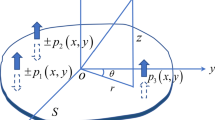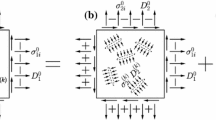Abstract
In this paper, the problem of the cracks with arbitrary forms in piezoelectric material is studied. The permittivity of the medium in the crack gap is considered. Except the collinear cracks, this boundary condition is too difficult to deal with; therefore, a perturbation method is recommended. By the way, the electric boundary conditions of electric fracture mechanics are discussed. For example, a small parameter solution of a crack is given and compared with the known `exact' (it will be discussed later) solution. This result shows that the impermeable or permeable conditions are only the boundary conditions for the first approximations of the perturbation solutions.
Similar content being viewed by others
References
Berlincourt, D.A., Curran, D.R. and Jaffe, H. (1964). Piezoelectric and piezoceramic materials and their function in transducers. In Physical acoustics (Edited by W.P. Mason), Vol. 1A. Academic Press, New York.
Cherepanov, G.P. (1977). Mechanics of Brittle Fracture. McGraw-Hill, New York.
Chien W.Z. (1980). Lecture on Perturbation Method. Tsinghua University, Beijing.
Eshelby J.D. (1956). The Continuum Theory of Dattice Defects Solid State Physics, Vol. 3, Academic Press.
Gao, H. Zhang, T.-Y. and Tong, P. (1997). Local and global energy release rates for an electrically yielded crack in a piezoelectric ceramics. J. Mech. Phys. Solids 45, 491–509.
Gao, Cun-Fa and Fan, Wei-Xun. (1999). Exact solution for the plane problem in piezoelectric materials with an elliptic hole or a crack. Int. J. Solids Structures 36, 2527–2540.
Hao, T.H. et al. (1994). A new electric boundary conditions of electric fracture mechanics and its applications. Engineering Fracture Mechanics 47, 793–802.
Hao, T.H. et al. (1996), Fracture mechanics for the design of ceramics multilayer actuators. J. Mech. Phys. Solids 44, 23–48.
Hao, T.H. (2001a). Multiple collinear cracks in a piezoelectric material. Int. J. Solids Structures 38, 9201–9208.
Hao, T.H. (2001b). Periodical collinear air-contain cracks in a piezoelectric material. Int. J. Fracture 112(3), 197–204.
Lekhnitskii, S.G. (1981). Theory of Elasticity of an Anisotropic Body. English edn. Mir, Moscow.
McMeeking, R.M. (1989). Electrostrictive stresses near crack-like flaws. Journal of Applied Mathematics and Physics 40, 615–627.
Mikhailov, G.K. and Parton, V.Z. (1990). Electromagnetoelasticity. Hemisphere, New York.
Muskhelishvili, N.I. (1963). Some Basic Problems of the Mathematical Theory of Elasticity. Noordhoff, Groningen, Holland.
Savin, G.N. (1961). Stress Concentration Around Holes. Pergamon Press, New York.
Suo, Z. (1991). Mechanical Concepts for Failure in Ferroelastic Ceramics, AD-Vol. 24/AMD-Vol. 123, Smart Structures and Materials, ASME.
Suo, Z., Kuo, C.M., Barnett, D.M. and Willis, J.R. (1992). Fracture mechanics for piezoelectric ceramics. J. Mech. Phys. Solids 40, 739–765.
Yang, W. and Suo, Z. (1994). Cracks in ceramic actuators caused by electrostriction. J. Mech. Phys. Solids 42, 649–663.
Yang, W. (2001). Mechatronic Reliability. Tsinghua University Press, Springer-Verlag, Beijing.
Yu, S.W. and Qin, Q.H. (1996a). Damage analysis of materials with thermopiezoelectric properties, part I: Crack tip singularities. Theor. Appl. Frac. Mech. 25, 263–277.
Yu, S.W. and Qin, Q.H. (1996b). Damage analysis of materials with thermopiezoelectric properties, part II: Effect crack model. Theor. Appl. Frac. Mech. 25, 279–288.
Zhang, T.Y., Zhao, M.H. and Tong, P. (2001); Fracture of piezoelectric ceramics. Advances in Applied Mechnic 38, 147–289.
Zhang, T.Y. et al. (2002). Interaction between a screw dislocation with an elliptic cavity in a piezoelectric material. Philosophical Magazin A 82(15), 2805–2824.
Author information
Authors and Affiliations
Rights and permissions
About this article
Cite this article
Tian-hu, H. Perturbation method of the piezoelectric fracture mechanics considering the permittivity of the medium in the crack gap. International Journal of Fracture 126, 57–69 (2004). https://doi.org/10.1023/B:frac.0000025280.46315.35
Issue Date:
DOI: https://doi.org/10.1023/B:frac.0000025280.46315.35




